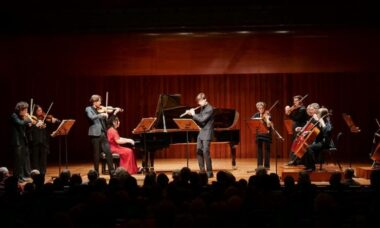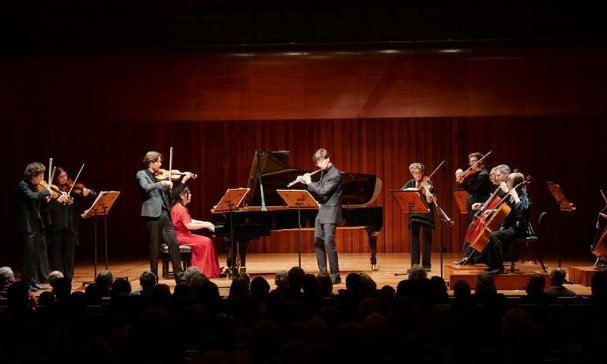 United Kingdom Various: Daria van den Bercken (piano), Thomas Hancox (flute), Britten Sinfonia / Thomas Gould (violin / director). Milton Court Concert Hall, London, 14.3.2023. (JC)
United Kingdom Various: Daria van den Bercken (piano), Thomas Hancox (flute), Britten Sinfonia / Thomas Gould (violin / director). Milton Court Concert Hall, London, 14.3.2023. (JC)

J S Bach – Brandenburg Concerto No.5
Mathilde Wantenaar – Rhapsody for Piano and Strings (world premiere)
David John Roche – Sentimental Espionage Music (world premiere)
Stravinsky – Dumbarton Oaks
Haydn – Symphony No.22 (‘The Philosopher’)
The Britten Sinfonia and pianist Daria van den Bercken presented a wonderfully fresh and well-curated programme to a very receptive audience at Milton Court Concert Hall last Friday evening.
The programme, while presenting works from the Baroque period all the way to world premieres, nevertheless had a strong and cohesive strand running through it: all four major works presented that evening paid homage to Baroque music in one way or another. Mathilde Wantenaar’s Rhapsody for Piano and Strings took Bach’s Brandenburg Concerto No.5 — opening piece of the evening — as its starting point, as well as incorporating aspects of the fugue in D minor from Book II of Bach’s Well-Tempered Clavier; in Stravinsky’s humorous and inventive concerto Dumbarton Oaks we see the avant-garde composer tipping his hat towards Baroque practices and conventions, while Haydn’s Symphony No.22 in E-flat major — in the same key as Dumbarton Oaks — begins by ‘alluding to a mysterious and antiquated “church” style in the opening movement’ (from programme notes) before shedding its disguise and taking off on a tour de force in the classical style.
I take pains to explain the cohesiveness of the programme because I cannot stress how much this well-balanced programme allowed me to listen to classical music with fresh ears. Despite the inclusion of canonical names like Bach and Haydn, it was clear that the pieces were put together to complement each other rather than simply supporting one big masterpiece. Thus, each piece performed sounded as wonderfully fresh as its predecessor. This experience was also helped by the freedom with which the players onstage approached the music.
The Britten Sinfonia players and Daria van den Bercken opened the evening with a brilliant performance of Bach’s Brandenburg Concerto No.5. Violinist Thomas Gould — who is also the leader of the Britten Sinfonia — carried with him an infectious enthusiasm for the music, while van den Bercken, playing the part of the harpsichord on a Steinway grand, rose to the challenge and was able to weave in and out of the texture, sometimes cushioning the sounds of the two other soloists and at other times launching into flourishes of virtuosic passages, conjuring beautiful colours on the way and culminating in a very exciting cadenza at the end of the first movement. There was wonderful musicianship between trio — Gould and van den Bercken alongside flautist Thomas Hancox – but it was the freedom with which they played and enjoyed themselves that really set us in the right mood.
Mathilde Wantenaar’s Rhapsody for Piano and Strings is a beautifully unpretentious and accessible piece bursting with creativity. Placed after the Brandenburg concerto, it seemed to show a modern twist on the excitement found in Bach’s counterpoint and polyphony, while injecting more contemporary rhythms into very simple and accessible melodic motifs. The music captured my attention with its ever-changing moods and waves of energy. Wantenaar seemed unafraid to make references, almost welcoming them: I detected hints of Bach, Bartók, Rachmaninov and even something that made me think of The Pirates of the Caribbean! Most importantly, it sounded like a lot of fun and couldn’t have had better performers to bring it alive for the first time in the public sphere than van den Bercken and the Britten Sinfonia.
After a brief piece — Sentimental Espionage Music — by David John Roche, the second half of the concert continued with Stravinsky’s Dumbarton Oaks concerto. To perform the concerto conductor-less is quite a challenge, but the performance worked well with Gould leading — whose enthusiasm and strong sense of rhythm were never lacking — allowing the audience to see how the players worked together, making the performance more exciting. The switch to a more classical style of playing for the Haydn symphony showed just how versatile the players of the Britten Sinfonia were. Kudos must be given especially to the horn players for tackling such a difficult part, but the virtuosity of this rather compact consort really deserved the applause they got that evening. All in all, a wonderfully programmed concert of light-heartedness and fun made all the better by a wonderful set of players.
Jeremy Chan
